
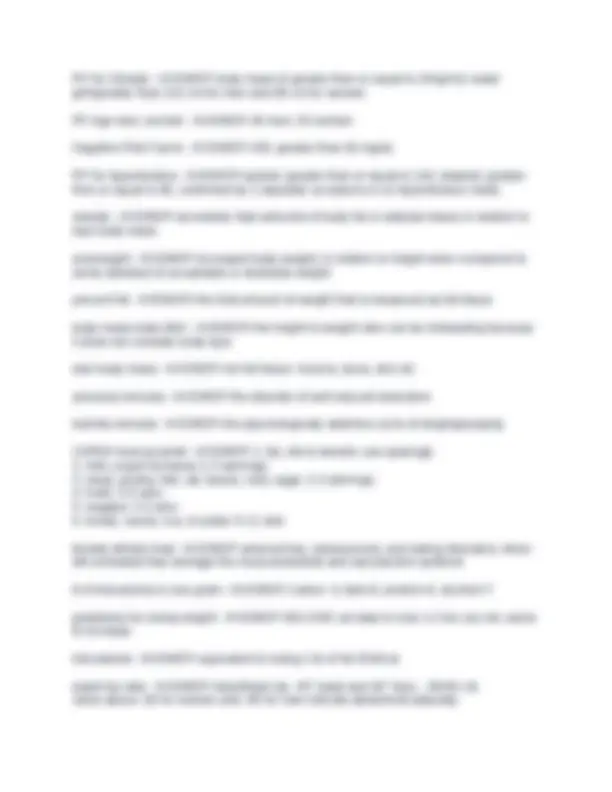
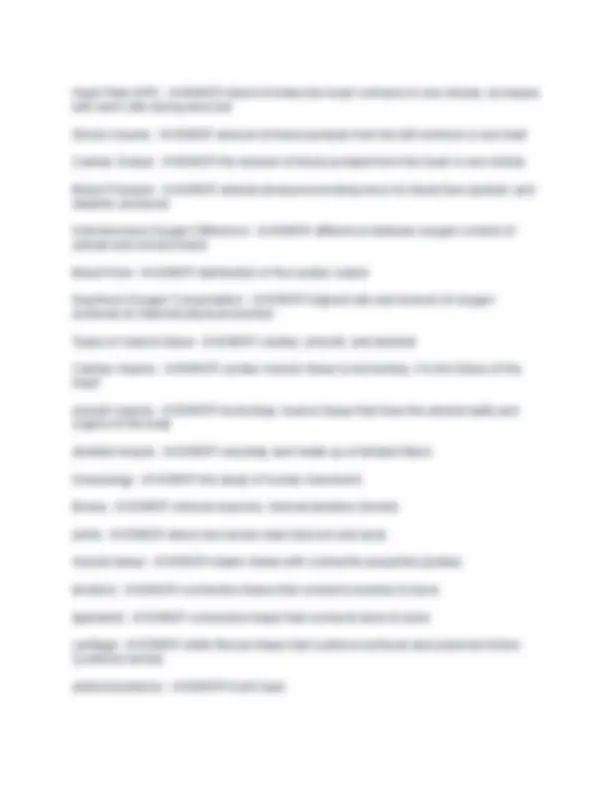
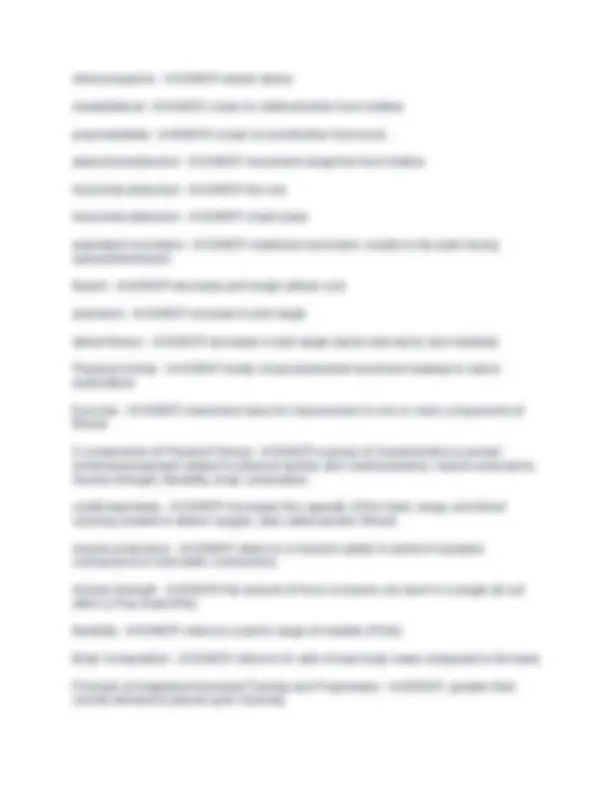
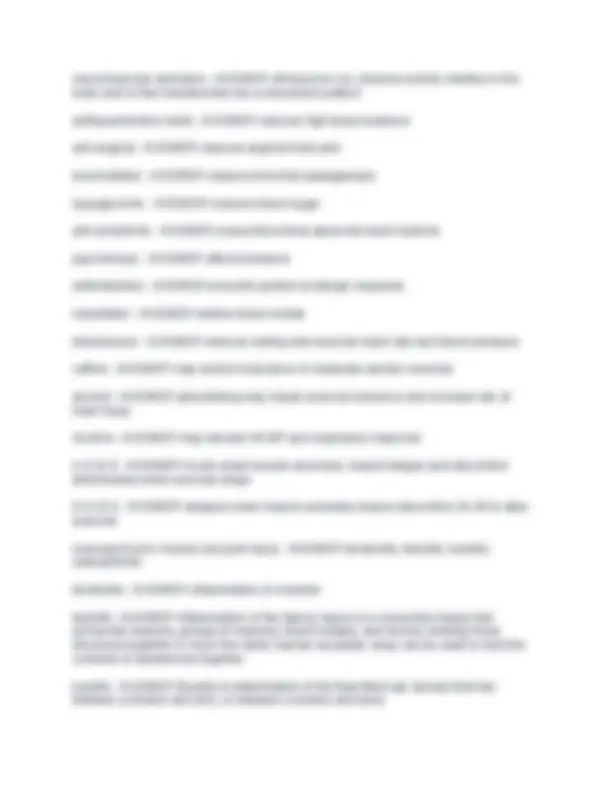
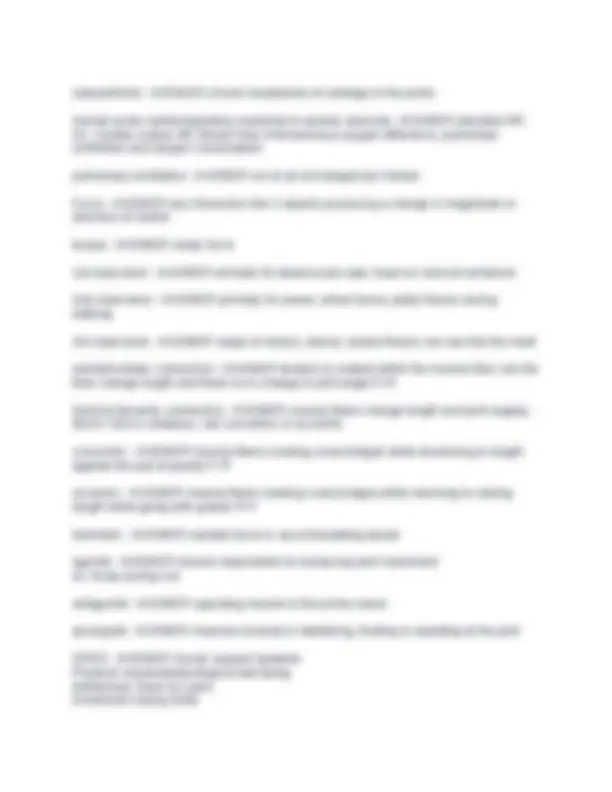
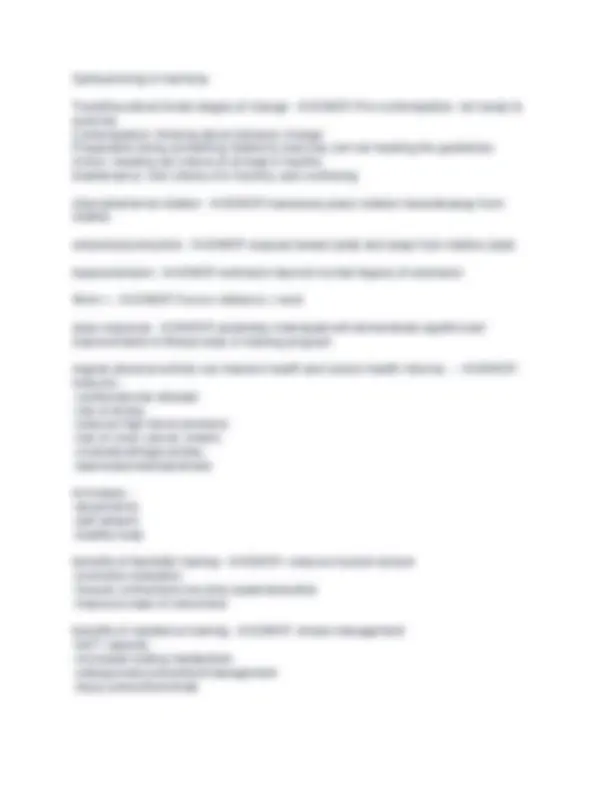
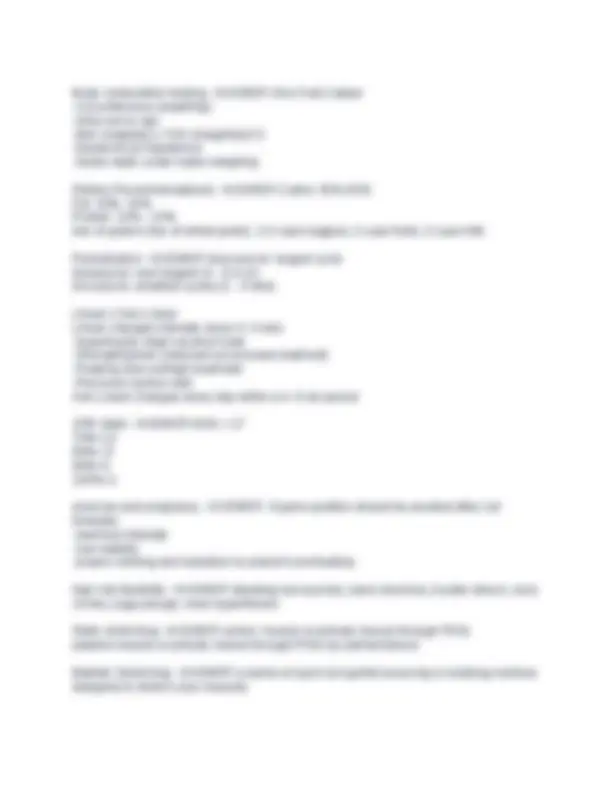
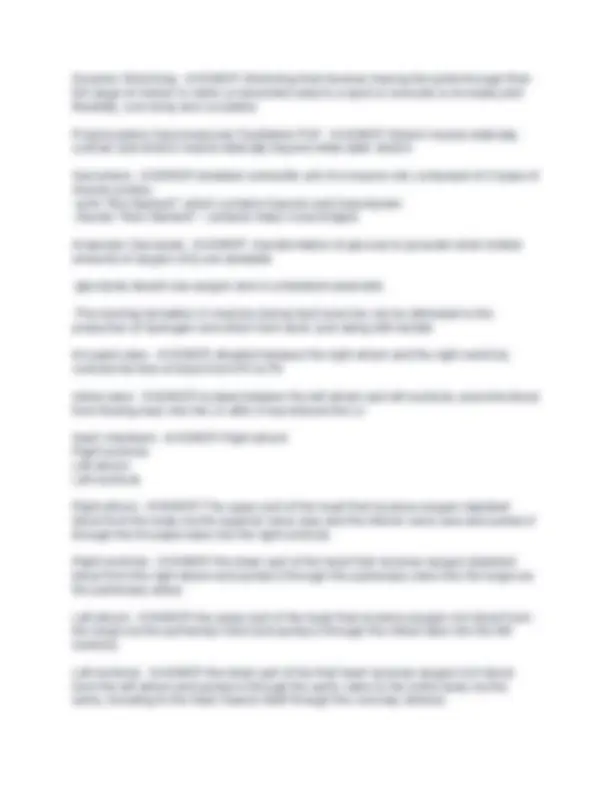
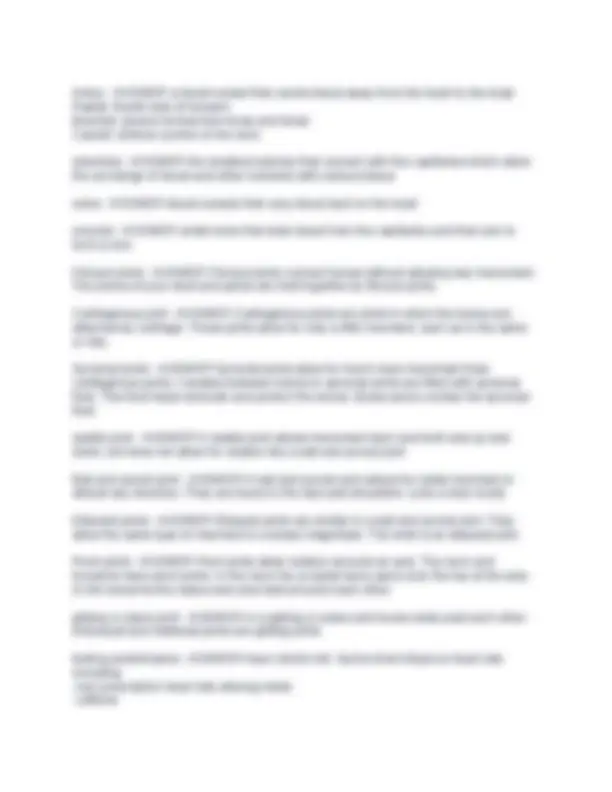
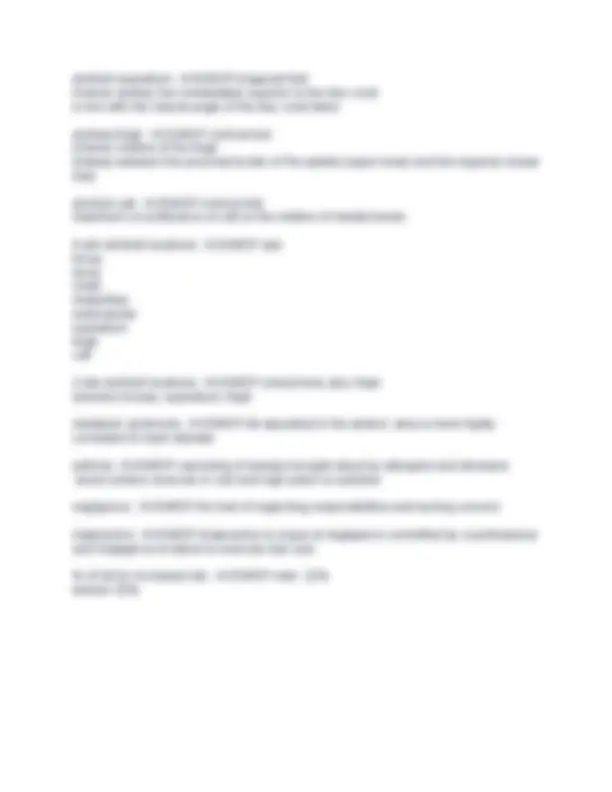


Study with the several resources on Docsity

Earn points by helping other students or get them with a premium plan


Prepare for your exams
Study with the several resources on Docsity

Earn points to download
Earn points by helping other students or get them with a premium plan
Community
Ask the community for help and clear up your study doubts
Discover the best universities in your country according to Docsity users
Free resources
Download our free guides on studying techniques, anxiety management strategies, and thesis advice from Docsity tutors
An overview of the human body's vertebral column, sternum, physical activity, and exercise. It covers the functions of the vertebral column, its curvatures, and common abnormalities. The sternum and its related movements are also discussed. Additionally, the document explains the concept of physical activity, exercise, and the five components of physical fitness. The text also covers the principles of adaptation and specificity of training, as well as various medications and their effects.
Typology: Exams
1 / 18

This page cannot be seen from the preview
Don't miss anything!











BIOMECHANICS - ANSWER-principles of physics related to energy and force as they apply to the human body PROXIMAL - ANSWER-CLOSER TO THE TRUNK DISTAL - ANSWER-further from the trunk SUPERIOR (CRANIAL) - ANSWER-above, toward the head INFERIOR (CAUDAL) - ANSWER-lower than, toward the feet ANTERIOR (VENTRAL) - ANSWER-toward the front POSTERIOR (DORSAL) - ANSWER-toward the back MEDIAL - ANSWER-closer to the midline LATERAL - ANSWER-further from the midline THREE CARDINAL BODY PLANES - ANSWER-sagittal plane, frontal plane, transverse plane SAGITTAL PLANE - ANSWER-makes a division into right and left portions FRONTAL PLANE - ANSWER-makes a division into anterior (front) and posterior (back) portions TRANSVERSE PLANE - ANSWER-makes a division into upper (superior) and lower (inferior) portions ROTATION - ANSWER-movement around a longitudinal axis, either toward or away from the midline CIRCUMDUCTION - ANSWER-a combination of flexion, extension, abduction, and adduction EVERSION - ANSWER-turning the sole of the foot away from the midline INVERSION - ANSWER-turning the sole of the foot toward the midline Bones of the skull, vertebral column, ribs, and sternum... - ANSWER-AXIAL SKELETON
VERTEBRAL COLUMN (SPINE) - ANSWER-serves as the main axial support for the body 4 Major curvatures of the adult vertebral column - ANSWER-cervical curve, thoracic curve, lumbar curve, sacral curve KYPHOSIS "primary curves" - ANSWER-curves of the thoracic and sacral regions LORDOSIS "secondary curves" - ANSWER-curves of the cervical and lumbar region Commonly found abnormal curves in the sagittal plane - ANSWER-hyperkyphosis and hyperlordosis HYPERKYPHOSIS - ANSWER-exaggerated posterior thoracic curvature HYPERLORDOSIS - ANSWER-exaggerated anterior lumbar curvature Commonly found abnormal curve in the frontal plane - ANSWER-scoliosis STERNUM - ANSWER-midline of the chest What are the 3 parts of the sternum? - ANSWER-manubrium, body, xiphoid process RF for family history - ANSWER-myocardial infarction, coronary revascularization or sudden death to a 1st degree family member when >55 male, >65 female RF for cigarette smoking - ANSWER-within 6 months Risk factor for Dyslipidemia LDL - ANSWER-Lgreater than 130 mg/dL RF Dyslipidemia Total Cholesterol - ANSWER-greater than 200 mg/dL RF Dyslipidemia low HDL - ANSWER-less than 40 mg/dL RF Sedentary minutes of activity, days of week, past # of months - ANSWER-less than 30 min/day, 3 days/week, for at least 3 months RF Prediabetes fasting blood glucose - ANSWER-greater than or equal to 100 mg/dL up to 126 greater than or equal to 126 mg/dL - ANSWER-Fasting Blood Glucose for Diabetes diagnosis
Heart Rate (HR) - ANSWER-total # of times the heart contracts in one minute, increases with work-rate during exercise Stroke Volume - ANSWER-amount of blood pumped from the left ventricle in one beat Cardiac Output - ANSWER-the amount of blood pumped from the heart in one minute Blood Pressure - ANSWER-arterial pressure providing force for blood flow (systolic and diastolic pressure) Arteriovenous Oxygen Difference - ANSWER-difference between oxygen content of arterial and venous blood Blood Flow - ANSWER-distribution of the cardiac output Maximum Oxygen Consumption - ANSWER-highest rate and amount of oxygen achieved at maximal physical exertion Types of muscle tissue - ANSWER-cardiac, smooth, and skeletal Cardiac muscle - ANSWER-cardiac muscle tissue is involuntary, it is the tissue of the heart smooth muscle - ANSWER-involuntary muscle tissue that lines the arterial walls and organs of the body skeletal muscle - ANSWER-voluntary and made up of striated fibers Kinesiology - ANSWER-the study of human movement Bones - ANSWER-mineral reservior, internal skeleton (levers) joints - ANSWER-where two bones meet (fulcrum and axis) muscle tissue - ANSWER-elastic tissue with contractile properties (pulley) tendons - ANSWER-connective tissue that connects muscles to bone ligaments - ANSWER-connective tissue that connects bone to bone cartilage - ANSWER-white fibrous tissue that cushions surfaces and prevents friction (cushions bones) anterior/posterior - ANSWER-front/ back
inferior/superior - ANSWER-below/ above medial/lateral - ANSWER-closer to midline/further from midline proximal/distal - ANSWER-closer to trunk/further from trunk abduction/adduction - ANSWER-movement away/into from midline horizontal abduction - ANSWER-the row horizontal adduction - ANSWER-chest press supination/ pronation - ANSWER-rotational movement, results in the palm facing upward/downward flexion - ANSWER-decrease joint angle (elbow curl) extension - ANSWER-increase in joint angle lateral flexion - ANSWER-decrease in joint angle (spine side bend, love handles) Physical Activity - ANSWER-bodily (musculoskeletal movement leading to caloric expenditure Exercise - ANSWER-movement done for improvement in one or more components of fitness 5 components of Physical Fitness - ANSWER-a group of characteristics a person achieves/possesses related to physical activity and cardiorepiratory, muscle endurance, muscle strength, flexibility, body composition cardiorespiratory - ANSWER-increases the capacity of the heart, lungs, and blood carrying vessels to deliver oxygen; also called aerobic fitness muscle endurance - ANSWER-refers to a muscle's ability to perform repeated contractions or hold static contractions muscle strength - ANSWER-the amount of force a muscle can exert in a single all-out effort (1 Rep Mas/1RM) flexibility - ANSWER-refers to a joint's range of mobility (ROM) Body Composition - ANSWER-refers to th ratio of lean body mass compared to fat mass Principle of Adaptation/Overload Training and Progression - ANSWER--greater then normal demand is placed upon muscles,
Hydration recommendations according to ACSM - ANSWER-approx. 3-6 ounces of water every 1-2 miles of the race ATP-PC phosphagen system (anaerobic) - ANSWER-25-30 seconds of high intesity work (spints, weight lifting) Anaerobic Glycolysis/Lactic Acid System (anaerobic) - ANSWER-1-2 min of high intensity work 400-800m distance sprint Oxygen System (aerobic) - ANSWER-fuels activities lasting more than 2-3 min. Capacity is limited only by oxygen and fuel avail. to the cell Ipsilateral - ANSWER-same Side Contralateral - ANSWER-opposite side unilateral - ANSWER-one side bilateral - ANSWER-both sides supine - ANSWER-lying face up prone - ANSWER-lying face down upper respiratory system - ANSWER-nose, sinuses, pharynx, larynx ...filters air lower respiratory system - ANSWER-trachea, bronchi, bronchiloes, alveoli...puts oxygen into blood anatomical sites of pulse - ANSWER-carotid, brachial, radial, femoral type 1 fibers - ANSWER-slow twitch, slow oxidative and red twitch fibers (aerobic) type IIA fibers - ANSWER-have aerobic and anaerobic capabilities and refered to as intermediate fibers, continuum fibers, fast oxidative glycolitic fibers type IIB - ANSWER-anaerobic in nature. refered as fast glycolitic fibers sliding filament theory - ANSWER-the events that occur b/w actin and myosin during muscle contraction and relaxation -when nerve impulse is received, the cross bridges of myosin will put the actin filaments towards the center of the sarcomere and tension is created
neuromuscular activation - ANSWER-stimulus for vol. physical activity initiates in the brain and is then transformed into a movement pattern antihypertensive meds - ANSWER-reduces high blood pressure anti-anginal - ANSWER-reduces angina/chest pain brochodilator - ANSWER-relaxes bronchial passageways hypoglycemic - ANSWER-reduces blood sugar anti-arrhythmic - ANSWER-prevents/controls abnormal heart rhythms psychotropic - ANSWER-affects behavior antihistamine - ANSWER-prevents system of allergic response vasodilator - ANSWER-widens blood vessal beta-blocker - ANSWER-reduces resting and exercise heart rate and blood pressure caffine - ANSWER-may extend endurance in moderate aerobic exercise alcohol - ANSWER-dehydrating-may impair exercise tolerance and increase risk of heart injury nicotine - ANSWER-may elevate HR,BP and respiratory response A.O.M.S - ANSWER-Acute-onset muscle soreness; muscle fatigue and discomfort dimininishes when exercise stops D.O.M.S - ANSWER-delayed onset muscle soreness;muscle discomfort 24-36 hr after exercise overuse/chronic muscle and joint injury - ANSWER-tendonitis, fasciitis, bursitis, osteoarthritis tendonitis - ANSWER-inflammation of a tendon fasciitis - ANSWER-inflammation of the fascia; fascia is a connective tissue that surrounds muscles, groups of muscles, blood vessels, and nerves, binding those structures together in much the same manner as plastic wrap can be used to hold the contents of sandwiches together bursitis - ANSWER-Bursitis is inflammation of the fluid-filled sac (bursa) that lies between a tendon and skin, or between a tendon and bone
Spiritual:living in harmony Transtheoretical Model stages of change - ANSWER-Pre-contemplation: not ready to exercise Contemplation: thinking about behavior change Preparation:doing something related to exercise, but not meeting the guidelines Action: meeting set criteria of at least 6 months Maintenance: met criteria of 6 months, and continuing internal/external rotation - ANSWER-transverse plane rotation towards/away from midline retraction/protraction - ANSWER-scapula toward (add) and away from midline (abd) hyperextension - ANSWER-extension beyond normal degree of extension Work = - ANSWER-Force x distance = work dose response - ANSWER-sedentary individuals will demonstrate significicant improvements in fitness early in training program regular physical activity can improve health and reduce health risks by... - ANSWER- reduces... -cardiovascular disease -risk of stroke -reduces high blood pressure -risk of colon cancer, lowers -cholesterol/triglycerides, -depression/anxiety/stress Increases... -lipoproteins -self-esteem -healthy body benefits of flexibility training - ANSWER--reduces muscle tension -promotes relaxation -muscle contractions become easier/smoother -improves ease of movement benefits of resistance training - ANSWER--stress management -MET capacity -increased resting metabolism -osteoporosis prevention/management -injury prevention/rehab
consequences of physical inactivity - ANSWER--heart disease -stroke -diabetes -hypertension -obesity -depression/anxiety -certain cancers Direction of blood flow - ANSWER-The Right Atrium, receives "used blood" from the body. Blood will be pushed through the tricuspid valve to the Right Ventricle, the chamber which will pump to the lungs through the pulmonic valve to the Pulmonary Arteries, providing blood to both lungs. Blood is circulated through the lungs where carbon dioxide is removed and oxygen added. It returns through the Pulmonary Veins, which empty into the Left Atrium, a chamber which will push the Mitral Valve open. Blood then passes into the Left Ventricle. As it pumps, the pressure will close the mitral valve and open the aortic valve, with blood passing through to the Aorta, where it will be delivered to the rest of the body. Mitral valve prolapse - ANSWER-heart problem resulting from the mitral valve not regulating the flow of blood between the left atrium and left ventricle of the heart Arrhythmias - ANSWER-An arrhythmia is a disorder of the heart rate (pulse) or heart rhythm, such as beating too fast (tachycardia), too slow (bradycardia), or irregularly. atrophy - ANSWER-decrease in the mass of the muscle;Muscle atrophy results from a co-morbidity of several common diseases, including cancer, AIDS, congestive heart failure, COPD (chronic obstructive pulmonary disease), renal failure, starvation hypertrophy - ANSWER-Enlargement of muscle 2 types of hypertrophy - ANSWER-sarcoplasmic and myofibrillar sarcoplasmic - ANSWER-volume of sarcoplasmic fluid in the muscle cell increases with no accompanying increase in muscular strength myofibrillar - ANSWER-actin and myosin contractile proteins increase in number and add to muscular strength as well as a small increase in the size of the muscle Par-Q - ANSWER-Physical Activity Readiness identifies people who should not be tested in a field setting. Proceed with caution if a client answers yes to one or more questions. May require physician clearance informed consent - ANSWER-lets person know there is a risk to exercise
Body composition testing - ANSWER-Skin Fold Caliper -Circumference (waist/hip) -Infra-red (x-ray) -BMI (mass(lb) x 703/ ((height(in))^ -bioelectrical Impedence -Hydro-static under water weighing Dietery Recommendations - ANSWER-Carbs: 55%-60% Fat: 25%- 30% Protein: 10% - 15% 6oz of grains (3oz of whole-grain), 2.5 cups veggies, 2 cups fruits, 3 cups milk Periodization - ANSWER-Macrocycle: largest cycle Mesocycle: next largest (4 - 6 in yr) Microcycle: smallest cycles (1 - 4 wks) Linear v Non Linear Linear changes intensity every 4- 6 wks -hypertrophy (high vol,short rest) -Strength/power (reduced vol,increase load/rest) -Peaking (low vol/high load/rest) -Recovery (active rest) Non Linear changes every day within a 4- 6 wk period 1RM table - ANSWER-60% = 17 70%= 80%= 8 90%= 100%= exercise and pregnancy - ANSWER--Supine position should be avoided after 1st trimester -low/mod intensity -non-ballistic -proper clothing and hydration to prevent overheating high risk flexibility - ANSWER-standing toe touches, barre streches, hurdler strech, neck circles, yoga plough, knee hyperflexion Static stretching - ANSWER-active: muscle is actively moved through ROM passive:muscle is actively moved through ROM by partner/device Ballistic Stretching - ANSWER-a series of quick but gentle bouncing or bobbing motions designed to stretch your muscles
Dynamic Stretching - ANSWER-Stretching that involves moving the joints through their full range of motion to mimic a movement used in a sport or exercise to increase joint flexibility, core temp and circulation Proprioceptive Neuromuscular Facilitation PNF - ANSWER-Stretch muscle statically, contract and stretch muscle statically beyond initial static stretch Sarcomere - ANSWER-smallest contractile unit of a muscle cell; composed of 2 types of muscle protein, -actin "thin filament", which contains troponin and tropomyosin -myosin "thick filament" : contains many cross bridges Anaerobic Glycolysis - ANSWER--transformation of glucose to pyruvate when limited amounts of oxygen (O2) are available -glycolysis doesnt use oxygen and is considered anaerobic -The burning sensation in muscles during hard exercise can be attributed to the production of hydrogen ions which form lactic acid along with lactate tricuspid valve - ANSWER-situated between the right atrium and the right ventricle; controls the flow of blood from RA to RV mitral valve - ANSWER-located between the left atrium and left ventricle; prevents blood from flowing back into the LA after it has entered the LV heart chambers - ANSWER-Right atrium Right ventricle Left atrium Left ventricle Right atrium - ANSWER-The upper part of the heart that receives oxygen-depleted blood from the body via the superior vena cava and the inferior vena cava and pumps it through the tricuspid valve into the right ventricle. Right ventricle - ANSWER-the lower part of the heart that receives oxygen-depleted blood from the right atrium and pumps it through the pulmonary valve into the lungs via the pulmonary artery. Left atrium - ANSWER-the upper part of the heart that receives oxygen-rich blood from the lungs via the pulmonary veins and pumps it through the mitral valve into the left ventricle. Left ventricle - ANSWER-the lower part of the that heart receives oxygen-rich blood from the left atrium and pumps it through the aortic valve to the entire body via the aorta, including to the heart muscle itself through the coronary arteries.
-exercise -large meals -fatigue -test anxiety 3 min step test - ANSWER-12" step 96 bpm locate radial pulse first client steps up up down down for 3 mins @ 96bpm with no talking check pulse within 5 secs after test Arthritis - ANSWER-inflammation of a joint -flex training recommended osteoarthritis - ANSWER--caused by mechanical stress and destruction of hyaline cartilage in the joints -many degrees of severity -degenerative arthritis rheumatoid - ANSWER-inflammation of synovial membrane, which then cause the body to initiate autoimmune response humerus - ANSWER-major bone of arm rotator cuff muscles - ANSWER-SITS Supraspinatus, Infraspinatus, Teres minor, Subscapularis major joint action for -pec major -post deltoid - ANSWER--shoulder horizontal adduction -shoulder horizontal abduction major joint action for -mid trap -pec minor - ANSWER--scapular retraction(add) -scapular protraction(abd) major joint action for -latissimus dorsi -middle delt - ANSWER--shoulder adduction -shoulder abduction major joint action for -rotator cuff muscles - ANSWER--shoulder abduction/ext rotation/int. rotation major joint action for
-erector spinae -abs - ANSWER--spinal extension/flexion major joint action for -biceps brachii -triceps brachii - ANSWER-elbow flexion elbow extension major joint action for -gluteus maximus -Ilopsoas - ANSWER-Hip Extension Hip Flexion major joint action for -quads -hams - ANSWER-knee extension knee flexion major joint action for -gastrocnemius -tibialis anterior - ANSWER-planter flexion dorsiflexion major joint action for -obliques - ANSWER-spinal rotation and lateral flexion skinfold abs - ANSWER-vertical fold 2cm right of belly button skinfold triceps - ANSWER-vertical fold posterior midline of middle right arm, halfway b/w the acromion(shoulder) and olecranon(elbow) processes skinfold bicep - ANSWER-vertical 1 cm above mark of tricep on belly of bicep skinfold chest/pec - ANSWER-diagonal fold half the distance b/w anterior axillary line and nipple (men) 1/3rd the distance b/w anterior axillary line and nipple (women) skinfold midaxillary - ANSWER-vertical fold Midaxillary line at the level of the xiphoid process of the sternum skinfold Subscapular - ANSWER-Diagonal fold 1 to 2 cm below the inferior angle of the scapula